SUZUKI JIMNY 2022 Workshop Manual
Manufacturer: SUZUKI, Model Year: 2022, Model line: JIMNY, Model: SUZUKI JIMNY 2022Pages: 421, PDF Size: 6.35 MB
Page 51 of 421
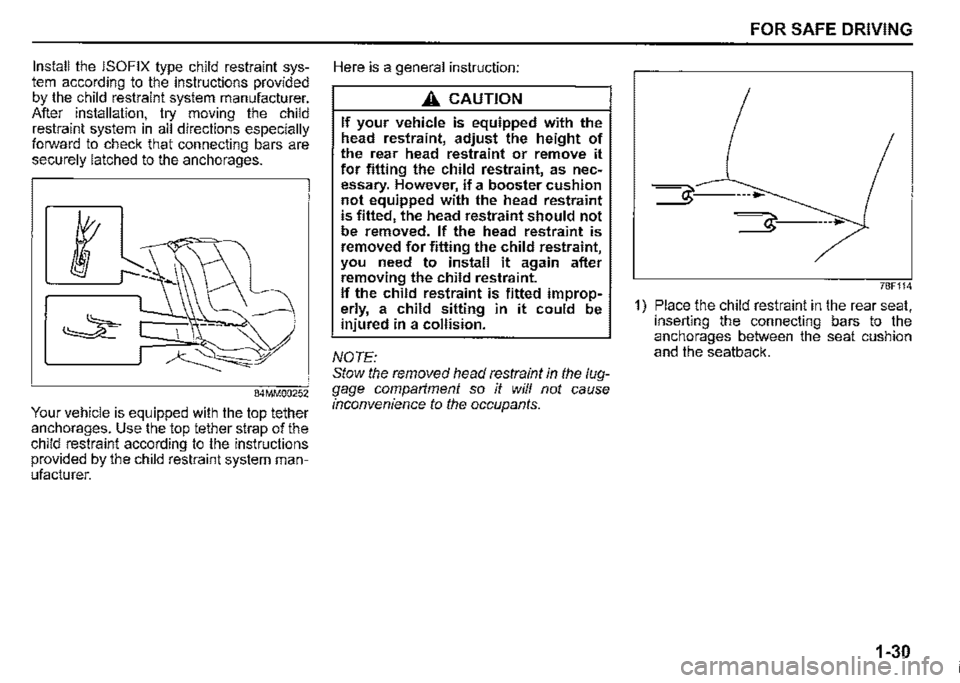
Install the ISOFIX type child restraint system according to the instructions provided by the child restraint system manufacturer. After installation, try moving the child restraint system in all directions especially forward to check that connecting bars are securely latched to the anchorages.
84MM00252
Your vehicle is equipped with the top tether anchorages. Use the top tether strap of the child restraint according to the instructions provided by the child restraint system manufacturer.
Here is a general instruction:
A CAUTION
If your vehicle is equipped with the head restraint, adjust the height of the rear head restraint or remove it for fitting the child restraint, as necessary. However, if a booster cushion not equipped with the head restraint is fitted, the head restraint should not be removed. If the head restraint is removed for fitting the child restraint, you need to install it again after removing the child restraint. If the child restraint is fitted improperly, a child sitting in it could be injured in a collision.
NOTE: Stow the removed head restraint in the luggage comparlment so it will not cause inconvenience to the occupants.
FOR SAFE DRIVING
it'---►
78F114
1) Place the child restraint in the rear seat, inserting the connecting bars to the anchorages between the seat cushion and the seatback.
1-30
Page 52 of 421
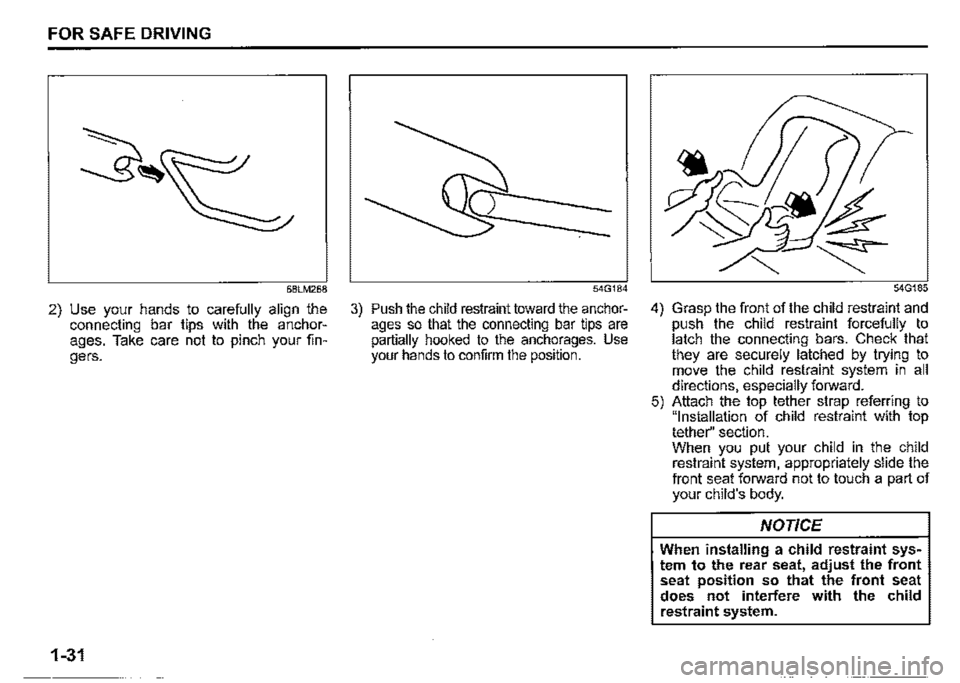
FOR SAFE DRIVING
68LM268
2) Use your hands to carefully align the connecting bar tips with the anchorages. Take care not to pinch your fingers.
1-31
54G184
3) Push the child restraint toward the anchorages so that the connecting bar tips are partially hooked to the anchorages. Use your hands to confirm the position.
54G185
4) Grasp the front of the child restraint and push the child restraint forcefully to latch the connecting bars. Check that they are securely latched by trying to move the child restraint system in all directions, especially forward. 5) Attach the top tether strap referring to "Installation of child restraint with top tether" section. When you put your child in the child restraint system, appropriately slide the front seat forward not to touch a part of your child's body.
NOTICE
When installing a child restraint system to the rear seat, adjust the front seat position so that the front seat does not interfere with the child restraint system.
Page 53 of 421
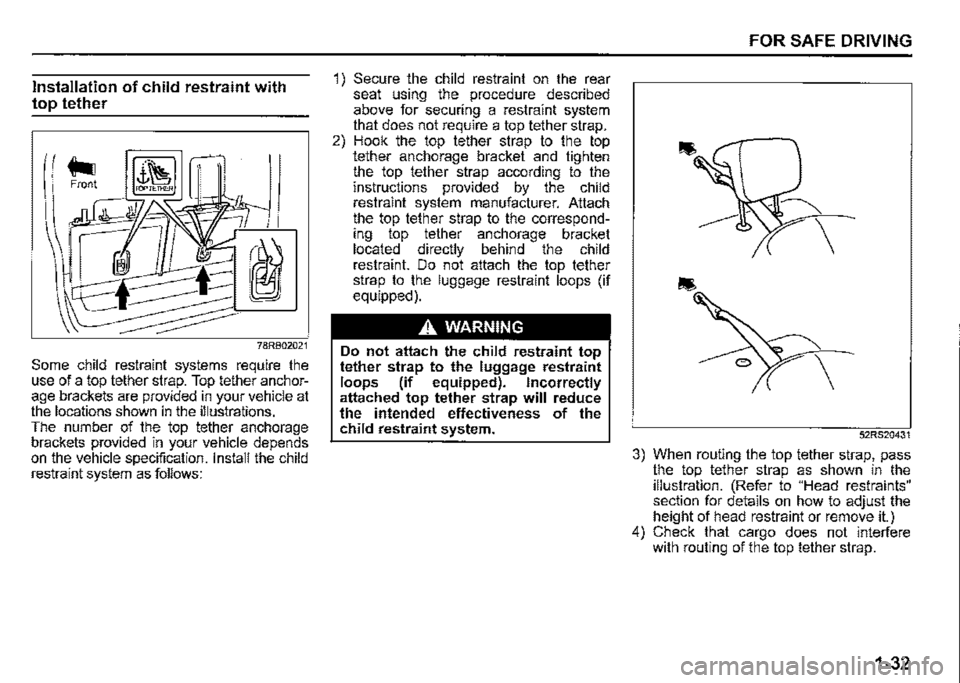
Installation of child restraint with
top tether
78RB02021
Some child restraint systems require the use of a top tether strap. Top tether anchorage brackets are provided in your vehicle at the locations shown in the illustrations. The number of the top tether anchorage brackets provided in your vehicle depends on the vehicle specification. Install the child restraint system as follows:
1) Secure the child restraint on the rear seat using the procedure described above for securing a restraint system that does not require a top tether strap. 2) Hook the top tether strap to the top tether anchorage bracket and tighten the top tether strap according to the instructions provided by the child restraint system manufacturer. Attach the top tether strap to the corresponding top tether anchorage bracket located directly behind the child restraint. Do not attach the top tether strap to the luggage restraint loops (if equipped).
A WARNING
Do not attach the child restraint top tether strap to the luggage restraint loops (if equipped). Incorrectly attached top tether strap will reduce the intended effectiveness of the child restraint system.
FOR SAFE DRIVING
52RS20431
3) When routing the top tether strap, pass the top tether strap as shown in the illustration. (Refer to "Head restraints" section for details on how to adjust the height of head restraint or remove it.) 4) Check that cargo does not interfere with routing of the top tether strap.
1-32
Page 54 of 421

FOR SAFE DRIVING
NOTICE
When installing a child restraint system to the rear seat, adjust the front seat position so that the front seat does not interfere with the child restraint system.
NOTE: For Australian models, refer to "For Australia" in the "SUPPLEMENT" section.
1-33
Seat belt pretensioner system
A WARNING
This section describes your SUZUKI vehicle's seat belt pretensioner system. Read and follow all these instructions carefully to minimize your risk of severe injury or death.
To determine if your vehicle is equipped with a seat belt pretensioner system at the front or rear seating positions, check the label on the seat belt at the bottom part. If the letters "p" and/or "PRE" appear as illustrated, your vehicle is equipped with the seat belt pretensioner system. You can use the pretensioner seat belts in the same manner as ordinary seat belts. Read this section and "Supplemental restraint system (airbags)" section to learn more about the pretensioner system.
The seat belt pretensioner system works with the supplemental restraint system (airbags). The crash sensors and the electronic controller of the airbag system also control the seat belt pretensioners. The pretensioners are triggered only when there is a frontal or side collision severe enough to trigger the airbags and the seat belts are fastened. For precautions and general information including servicing the pretensioner system, refer to "Supplemental restraint system (airbags)" section in addition to this "Seat belt pretensioner system" section, and follow all those precautions.
Page 55 of 421
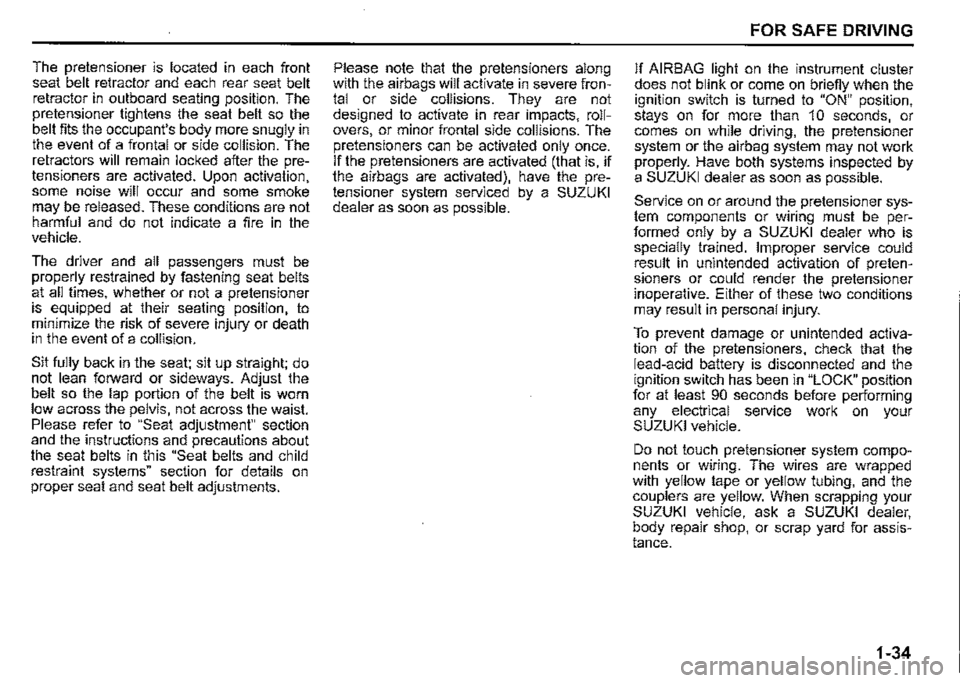
The pretensioner is located in each front seat belt retractor and each rear seat belt retractor in outboard seating position. The pretensioner tightens the seat belt so the belt fits the occupant's body more snugly in the event of a frontal or side collision. The retractors will remain locked after the pretensioners are activated. Upon activation, some noise will occur and some smoke may be released. These conditions are not harmful and do not indicate a fire in the vehicle.
The driver and all passengers must be properly restrained by fastening seat belts at all times, whether or not a pretensioner is equipped at their seating position, to minimize the risk of severe injury or death in the event of a collision.
Sit fully back in the seat; sit up straight; do not lean forward or sideways. Adjust the belt so the lap portion of the belt is worn low across the pelvis, not across the waist. Please refer to "Seat adjustment" section and the instructions and precautions about the seat belts in this "Seat belts and child restraint systems" section for details on proper seat and seat belt adjustments.
Please note that the pretensioners along with the airbags will activate in severe frontal or side collisions. They are not designed to activate in rear impacts, rollovers, or minor frontal side collisions. The pretensioners can be activated only once. If the pretensioners are activated (that is, if the airbags are activated), have the pretensioner system serviced by a SUZUKI dealer as soon as possible.
FOR SAFE DRIVING
If AIRBAG light on the instrument cluster does not blink or come on briefiy when the ignition switch is turned to "ON" position, stays on for more than 1 O seconds, or comes on while driving, the pretensioner system or the airbag system may not work properly. Have both systems inspected by a SUZUKI dealer as soon as possible.
Service on or around the pretensioner system components or wiring must be performed only by a SUZUKI dealer who is specially trained. Improper service could result in unintended activation of pretensioners or could render the pretensioner inoperative. Either of these two conditions may result in personal injury.
To prevent damage or unintended activation of the pretensioners, check that the lead-acid battery is disconnected and the ignition switch has been in "LOCK" position for at least 90 seconds before performing any electrical service work on your SUZUKI vehicle.
Do not touch pretensioner system components or wiring. The wires are wrapped with yellow tape or yellow tubing, and the couplers are yellow. When scrapping your SUZUKI vehicle, ask a SUZUKI dealer, body repair shop, or scrap yard for assistance.
1-34
Page 56 of 421

FOR SAFE DRIVING
Supplemental restraint
system (airbags)
,A. WARNING
This section describes the protection provided by your SUZUKI vehicle's supplemental restraint system (airbags). Read and follow all instructions carefully to minimize your risk of severe injury or death in the event of a collision.
Your vehicle is equipped with a supplemental restraint system consisting of the following components in addition to a lapshoulder belt at each seating position.
(1) Forward crash sensor (2) Side crash sensor (if equipped) (3) Driver's front airbag module (4) Side curtain airbag module (if equipped) (5) Front passenger's front airbag module (6) Side airbag module (if equipped) (7) Front seat belt pretensioners (if equipped) (8) Rear seat belt pretensioners (if equipped) (9) Airbag controller
1-35
2 3
9 6 7
4 5 2 4 6 8
' ., : I!,..---._ -----': ~ /~~wcil',,.--··---.~:r
1_;· v-;
2 8 7 2
78RB02022
Page 57 of 421
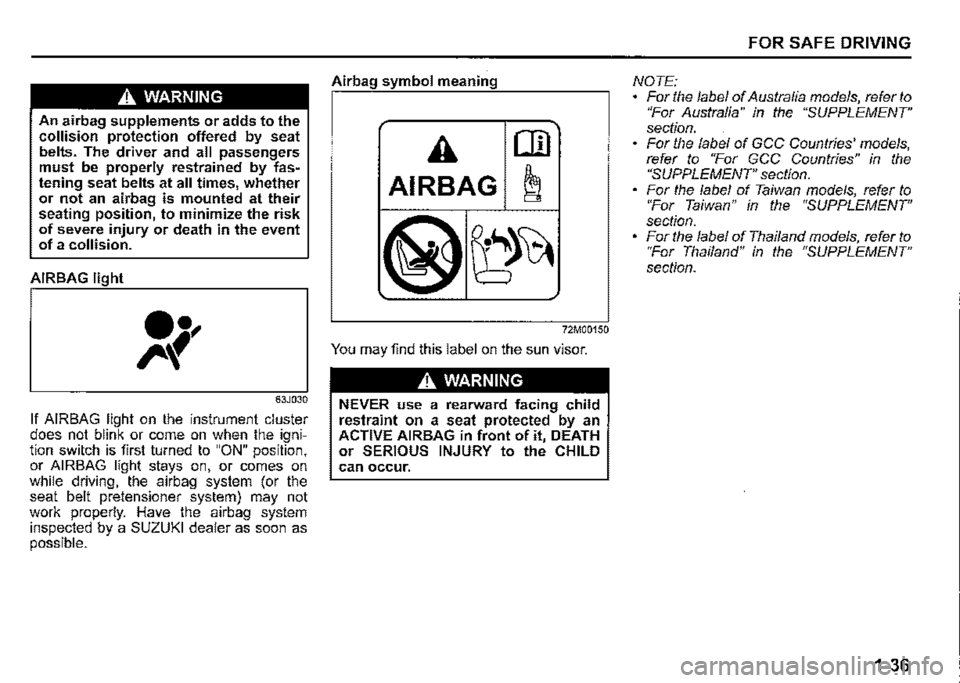
A. WARNING
An airbag supplements or adds to the collision protection offered by seat belts. The driver and all passengers must be properly restrained by fastening seat belts at all times, whether or not an airbag is mounted at their seating position, to minimize the risk of severe injury or death in the event of a collision.
AIRBAG light
63J030
If AIRBAG light on the instrument cluster does not blink or come on when the ignition switch is first turned to "ON" position. or AIRBAG light stays on, or comes on while driving, the airbag system (or the seat belt pretensioner system) may not work properly. Have the airbag system inspected by a SUZUKI dealer as soon as possible.
Airbag symbol meaning
A Dll
AIRBAG ~
®
@t
72M00150
You may find this label on the sun visor.
A. WARNING
NEVER use a rearward facing child restraint on a seat protected by an ACTIVE AIRBAG in front of it, DEATH or SERIOUS INJURY to the CHILD can occur.
FOR SAFE DRIVING
NOTE: For the label of Australia models, refer to "For Australia" in the "SUPPLEMENT" section. For the label of GCC Countries' models, refer to "For GCC Countries" in the "SUPPLEMENT" section. For the label of Taiwan models, refer to "For Taiwan" in the "SUPPLEMENT" section. For the label of Thailand models, refer to "For Thailand" in the "SUPPLEMENT" section.
1-36
Page 58 of 421
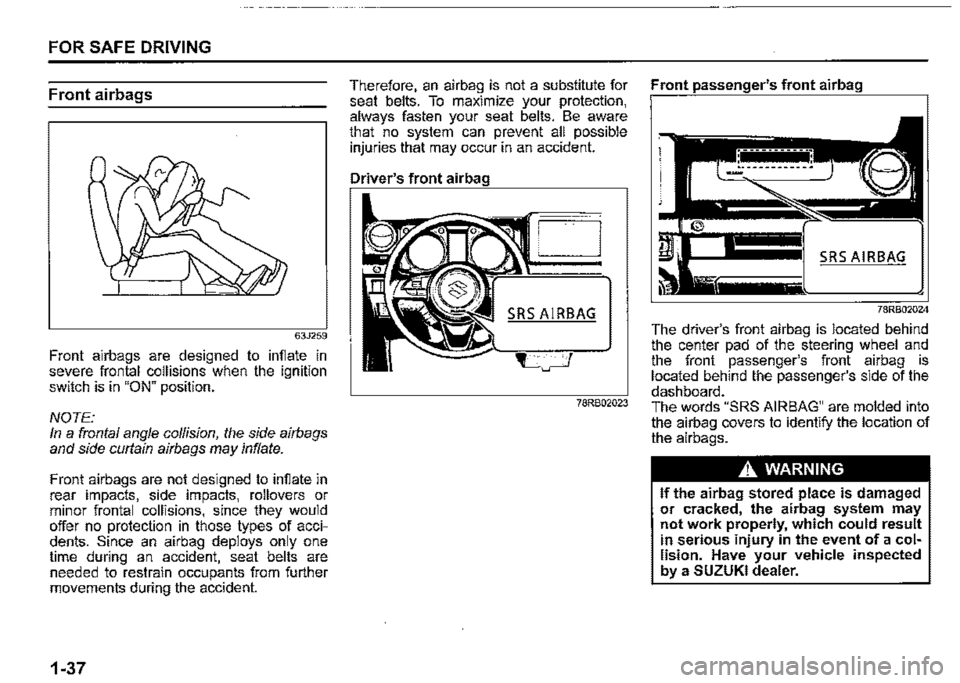
FOR SAFE DRIVING
Front airbags
63J259
Front airbags are designed to infiate in severe frontal collisions when the ignition switch is in "ON" position.
NOTE: In a frontal angle collision, the side airbags and side cwtain airbags may inflate.
Front airbags are not designed to infiate in rear impacts, side impacts, rollovers or minor frontal collisions, since they would offer no protection in those types of accidents. Since an airbag deploys only one time during an accident, seat belts are needed to restrain occupants from further movements during the accident.
1-37
Therefore, an airbag is not a substitute for Front passenger's front airbag seat belts. To maximize your protection, always fasten your seat belts. Be aware that no system can prevent all possible injuries that may occur in an accident.
Driver's front airbag
D
SRS AIRBAG
78RB02023
SRS AIRBAG
78RB02024
The driver's front airbag is located behind the canter pad of the steering wheel and the front passenger's front airbag is located behind the passenger's side of the dashboard. The words "SRS AIRBAG" are melded into the airbag covers to identify the location of the airbags.
A WARNING
If the airbag stored place is damaged or cracked, the airbag system may not work properly, which could result in serious injury in the event of a collision. Have your vehicle inspected by a SUZUKI dealer.
Page 59 of 421

58MS030
.A WARNING
(Vehicle without the front passenger airbag deactivation system) Do not install a rear-facing child restraint in the front passenger's seat. If the passenger's front airbag inflates, a child in a rear-facing child restraint could be killed or severely injured. The back of a rear-facing child restraint would be too close to the inflating airbag.
Conditions of front airbags may inflate
.A WARNING
(Vehicle with the front passenger airbag deactivation system) When using child restraint system on the front passenger's seat, the front passenger's airbag system must be deactivated; otherwise deployment of the front passenger's airbag could result in the death or serious injury of the child.
Refer to "Seat belts and child restraint systems" section for details on securing your child .
FOR SAFE DRIVING
Conditions of front airbags deployment (inflation)
80J097
Frontal collision with a fixed wall that does not move or deform at more than about 25 km/h (15 mph)
80J098E
Strong impact equivalent to frontal collision such as above at left and right angles of about 30 degrees (1) or less from the front of your vehicle
1-38
Page 60 of 421

FOR SAFE DRIVING
Receiving a strong impact to the lower body of your vehicle, the front airbags may infiate.
80J099
• Hitting a curb or medial strip
80J100E
• Falling into a deep hole or ditch
1-39
80J101
• Landing hard or falling
Front airbags may not inflate The front airbags may not infiate when a strong impact has not occurred since the collision object was easy to be deformed or moved, or the crashed portion of your vehicle was easy to be deformed. Also, front airbags may not inflate in many cases when the collision angle is greater than about 30 degrees at left and right angles from the front of your vehicle.
80J102
Frontal collision to a stopped vehicle at less than about 50 km/h (30 mph)